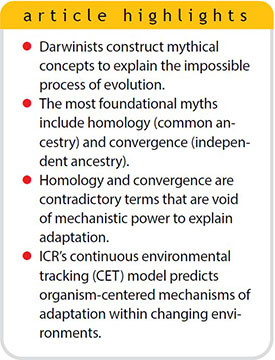Staff Writer
Foundational interpretations of Darwinian evolution are built upon two conceptual pillars: homology and convergence. Homology proposes that specific characters—including the genes, cells, body plans, and adaptations of every animal—can be traced through a series of common ancestors. Convergence proposes that characters evolve independently from different ancestors to produce superficially similar traits for a similar purpose.
and convergence. Homology proposes that specific characters—including the genes, cells, body plans, and adaptations of every animal—can be traced through a series of common ancestors. Convergence proposes that characters evolve independently from different ancestors to produce superficially similar traits for a similar purpose.
These concepts directly contradict one another. For instance, conventional science suggests that the bones forming the structure of wings in birds and bats are homologous while the wings themselves are convergent. Really? No! Evolutionary concepts are highly flexible fabrications of the human mind, intended to replace the true origin and diversification of all biodiversity on Earth.
Currently, there’s a trend toward invoking convergence to reinterpret major themes in evolutionary biology, focusing on molecular and cellular evidence of adaptive traits. Examples include the transition of plants from water to land by convergent gene regulatory networks,1 extremely low reflectance of ultra-black deep-sea fishes by convergent arrangements of melanosomes,2 convergent increases in oxygen affinity by hemoglobin in high-altitude birds,3 repeated convergence of wing-pattern mimicry in butterflies by a single transcription factor,4 and convergent genetics that produce similar responses to climate by distinct woodpecker species.5
The adaptations listed above were not induced by shared ancestry or “selected” through personified forces of nature. They are functional products of distinct organism-centered responses to similar environmental conditions. Darwin’s presumptions of “random mutation” and “natural selection” in each case are as undetectable as the endless chain of mythical ancestors assumed to have preceded each of those wonderous creations.
Let’s take a closer look at multiple changes in the features of blind cavefish (Astyanax mexicanus) under investigation at the Institute for Creation Research. According to evolutionists, rapid convergent evolution is the most prevalent explanation for the loss and gain of adaptive traits in cave environments. They believe that random mutations have destroyed certain functional pathways. Proposed losses include eyes, melanin pigmentation, schooling behavior, and sleep.6 Notable gains include increases in olfactory lobes (smell), jaw size, taste buds and teeth (feeding), storage of fat (metabolism), and enhanced neuromasts (lateral line) to facilitate vibrational attraction behavior in complete darkness.
Additional adaptations reveal increased gill size, greater surface area of red blood cells, larger blood cells, and higher levels of hemoglobin expression during development and adulthood.6,7 These adaptations bind, transport, and deliver more oxygen per blood cell to optimize respiration at genetic, molecular, cellular, and physiological levels in low-oxygen cave environments.
As of 2018, more than 230 cavefish species had been identified across all continents except Antarctica.8 Similar cave-dwelling adaptations are also observed in salamanders, crustaceans, insects, arachnids, myriapods, annelids, turbellarians, and gastropods, which also exhibit blindness, reduction of pigment, and enhancements in other traits.9 They’re promoted as clear examples of “convergence” on a global scale, but are they truly convergent? As with homology, convergence is an attempt to discount the true source of adaptive biology. Such broad conceptual myths are void of mechanistic and explanatory power.
From a biblical perspective, we expect to observe common traits within different organisms inhabiting similar environments—as exemplified by ICR’s model of continuous environmental tracking (CET), in which every organism is an active, problem-solving entity with a capacity to self-adjust to environmental challenges. What appear as homologous or convergent traits are actually rapid, repeatable, and tightly regulated solutions for a range of conditions to which animals are exposed.
Life is not the result of evolutionary processes. It is thoughtfully and intentionally prepared by the infinite wisdom of our Creator, the Lord Jesus, “in whose hand is the life of every living thing, and the breath of all mankind” (Job 12:10).
References
- Artur, M. A. S. and K. Kajala. 2021. Convergent Evolution of Gene Regulatory Networks Underlying Plant Adaptations to Dry Environments. Plant, Cell & Environment. 44 (10): 3211-3222.
- Davis, A. L. et al. 2020. Ultra-black Camouflage in Deep-sea Fishes. Current Biology. 30 (17): P3470-3476.E3.
- Natarajan, C. et al. 2016. Predictable Convergence in Hemoglobin Function Has Unpredictable Molecular Underpinnings. Science. 354 (6310): 336-339.
- Reed, R. D. et al. 2011. optix Drives the Repeated Convergent Evolution of Butterfly Wing Pattern Mimicry. Science. 333 (6046): 1137-1141.
- Moreira, L. R. and B. T. Smith. 2023. Convergent Genomic Signatures of Local Adaptation Across a Continental-scale Environmental Gradient. Science Advances. 9 (2): eadd0560.
- Jeffery, W. R. 2020. Astyanax Surface and Cave Fish Morphs. EvoDevo. 11: 1-10.
- Boggs, T. E., J. S. Friedman, and J. B. Gross. 2022. Alterations to Cavefish Red Blood Cells Provide Evidence of Adaptation to Reduced Subterranean Oxygen. Scientific Reports. 12: 3735.
- Borowsky, R. 2018. Cavefishes. Current Biology. 28 (2): R60-R64.
- White, W. B., D. C. Culver, and T. Pipan. 2019. Encyclopedia of Caves, 3rd ed. Cambridge, MA: Academic Press.
















